 Applying the Theory of Constraints to the design, resourcing and management of the sales process
Applying the Theory of Constraints to the design, resourcing and management of the sales process
[Presented at: TOCICO Conference, Miami 2004]
Introduction
The traditional sales process is hard to manage and all but impossible to scale.
This paper introduces a radical new approach to sales process design, resourcing and management.
The result of this approach is a process where:
- Salespeople consistently perform five appointments a day, five days a week.
- Appointments are programmed into salespeople’s diaries in descending order of probable contribution.
- A buffer of sales opportunities is generated and maintained, without requiring any involvement of salespeople.
- Budgets, targets, bonuses and commissions are eliminated and all activities are synchronised (in real-time) with the goal* of the organisation.
The problem with the sales process
Most sales processes are not processes in any useful sense of the word.
In a production context, the word process conjures up images of a production line — a series of tightly-coordinated activities that deftly converts raw materials into finished goods.
A typical sales process hardly fits this description.
A typical sales process consists of a number of individuals, each of whom is responsible for the entire sales function (and for a number of non-sales activities). Rather than following any formal procedure, these individuals engage in a broad range of ad hoc activities — using intuition to make resource allocation decisions.
A typical sales process is not dissimilar to a manufacturing process prior to the industrial revolution:
- All tasks are performed by skilled technicians.
- There is minimal automation.
- Each technician operates in parallel with others — rather than in series. Accordingly, each worker is responsible for his own end-to-end process.
- There is enormous variation in output.
- Because there are no economies of scale, the system is difficult to scale.
- Technicians receive performance pay, meaning that they are inclined to behave like sub-contractors
- There are no disincentives for technicians to set up their own competitive businesses.
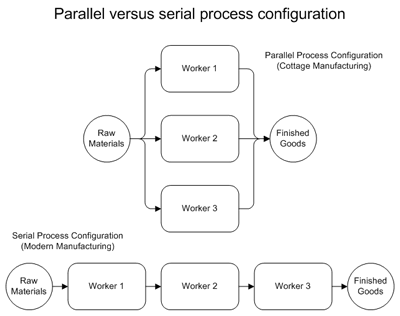
(Technically, it makes sense to apply the word ‘process’ only to the latter configuration in the diagram above.)
Fortunately, if we are looking to increase the productivity of the sales process, modern manufacturing provides us with clear guidance.
Applying TOC to the sales process
TOC’s five focusing steps* advise us to begin by identifying the constraint.
Because the salesperson is the traditional sales process’s only resource, it’s obvious that the salesperson is the capacity constrained resource (CCR).
To determine how to exploit the CCR, we’ll perform a simple time and motion study.
A review of a typical salesperson’s time and activities is likely to reveal the following breakdown of activities:
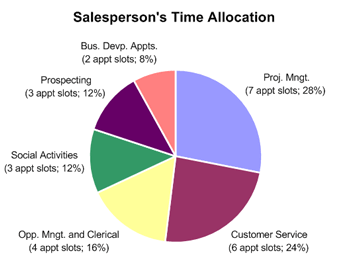
As illustrated, a typical salesperson conducts just two business-development appointments a week.
The balance of his time is allocated to:
- Project management: managing the delivery of prior sales
- Customer service: receiving and processing repeat transactions
- Opportunity management and clerical tasks: activity programming, diary management, data entry and literature fulfilment
- Social activities: appointments with no formal business objective, as well as a range of overtly non-commercial activities (often involving sport)
- Prospecting: identifying sales opportunities
The following table ranks these activities by time allocated (descending order) and by the contribution each activity makes to Throughput*.
| Activity |
Time allocated |
Contrib. to T’put |
| Project management |
1 |
NA |
| Customer service |
2 |
NA |
| Opportunity management and clerical tasks |
3 |
3 |
| Social activities |
4 |
NA |
| Prospecting |
5 |
2 |
| Business-development appointments |
6 |
1 |
Where the contribution to Throughput is concerned, project management, customer service and social activities are marketed as not applicable. This is because it simply does not make sense to treat these activities as part of the sales process*.
While the exclusion of social activities from the sales process is contentious, we do so for two reasons:
- We consistently find that we can get a better return on scarce resources from commercial activities than we can from social activities.
- Even if social relationships are an antecedent of commercial relationships (which is debatable**), such relationships should be regarded by management as a contingent liability.
Of the three remaining activities, business-development appointments obviously make the greatest contribution to Throughput.
These appointments are a higher-probability activity than prospecting. While opportunity management and clerical tasks are necessary, they do not make a direct contribution to Throughput.
Because the conduct of business-development appointments is the salesperson’s most productive activity, we will establish the appointment slot as our unit of constraint. In our experience, a salesperson’s maximum sustainable capacity is likely to be five appointments a day.*
For this reason, the pie chart on the preceding page, displays time allocated to activities in terms of appointment slots consumed.
It should now be obvious that:
- Our sales process will be at its most productive when we have maximised Throughput per appointment slot available (T/ASA).
- The measure of the contribution of our salesperson to the process as a whole will be Throughput per appointment slot consumed (T/ASC).
Accordingly, our focus should now be on:
- Ensuring that our salesperson is fully utilised (all his available appointment slots are consumed).
- Programming activities into our salesperson’s diary so as to maximise T/ASC.
A word on programming
In our experience, neither salespeople nor management are ever likely to have considered a formal approach to the programming of sales activities.
Consequently, salespeople’s time tends to be programmed by salespeople themselves — with intuition as the prevailing method.
Unfortunately, as is illustrated by the popularity of casinos, the human brain does not excel at performing estimates where probability is involved. The result is that low-probability activities are likely to be given priority over higher-probability activities. (Salespeople over-estimate the value of the unknown.)
This has a deleterious effect on both process throughput and conversion rates.*
The sales coordinator
In order to maximise both the utilisation and the productivity of the CCR (the salesperson), we focus the salesperson exclusively on business-development appointments and add an upstream resource called a sales coordinator.
The sales coordinator is responsible for ensuring that the salesperson is fully utilised at all times (five business-development appointments a day, five days a week).
Consequently, the sales coordinator takes total control of the salesperson’s diary (just as a personal assistant would take control of an executive’s diary).
In order to maximise the salesperson’s productivity (T/ASC) the sales coordinator allocates appointments in the descending order of their probable contribution. Because the sales coordinator’s intuition is no more capable of estimating this contribution than the salesperson’s, these critical programming decisions are made using a formula provided by management.
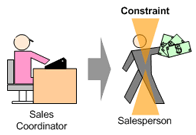
Feeding the constraint
As suggested previously, we are only interested in the salesperson performing business-development appointments.
These are appointments with a commercial agenda that has been approved in advance by the potential client.
At some stage, the sales coordinator is likely to find it difficult to schedule appointments that comply with this precondition.
This is because, prior to agreeing to such an appointment, the potential client (prospect) must acknowledge a requirement for the product or service that the salesperson is representing.
While, for most organisations, there is no shortage of prospects, there is a shortage of prospects with a current acknowledged need (this is what we call a sales opportunity).
At this point, we are in danger of the constraint shifting from the salesperson to the sales coordinator.
In order to prevent this from happening, we must:
- Identify the source of — and a method to generate — sales opportunities.
- Build a buffer of these opportunities (an opportunity buffer) upstream from the sales coordinator.
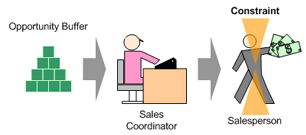
The source of sales opportunities: four theories
We find that most organisations have designed their sales process based upon one of four theories concerning the (primary) source of sales opportunities:
- That sales opportunities are a raw material (and, therefore, abundant)
- That salespeople create sales opportunities (as a result of their prospecting activities)
- That promotional campaigns generate sales opportunities
- That existing clients are the source of sales opportunities (either directly, or via referrals)
While there is a set of circumstances in which each of these theories is appropriate, few organisations find themselves complying with those circumstances.
The result, for most organisations, is a chronic shortage of sales opportunities. This persistent scarcity of sales opportunities, in turn, encourages organisations to design their sales processes to maximise conversion rates, at the expense of process volume.
The theory that sales opportunities are a raw material is appropriate only for those organisations with a production — rather than a sales process — constraint.
The theory that salespeople are the primary source of sales opportunities is applicable only in situations where salespeople can prospect and sell concurrently (e.g. door-to-door sales). In other situations, prospecting is such a resource-intensive activity that it consumes the greater majority of a salesperson’s available time.
The theory that promotional campaigns are the primary source of sales opportunities is applicable only to organisations that change their products regularly (entertainment promoters, infomercial marketers, property developers etc). This is because promotional campaigns that directly generate sales opportunities tend to suffer from rapidly-diminishing returns.
The theory that existing clients are the primary source of sales opportunities is appropriate only for organisations with an enormous, under-exploited client base (telecoms, utilities etc). For other organisations, this theory results in a sales process that is a self-contained (self-limiting) system.
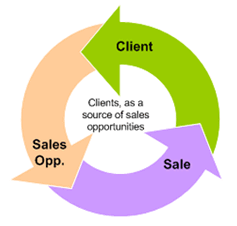
Relationships as a source of sales opportunities
Curiously, for most organisations, it is true that clients are the primary source of sales opportunities. That said, if the objective is to increase process output at anything other than an incremental rate, it doesn’t make sense to look to existing clients to drive this growth.
Our solution is to recognise relationships as the primary source of sales opportunities.
Our interest, then, is not just in customer relationships, but in relationships with the organisation’s marketplace as a whole, where this marketplace consists of:
- Customers
- Potential customers
- Centers of influence
We have observed that, in most instances, there is a predictable, linear correlation (suggesting cause and effect) between the number of relationships an organisation has under management and the volume of inbound, unsolicited sales opportunities.
This phenomenon is dependent upon:
- A base of relationships that is large enough to be representative of the marketplace
- Some kind of periodic and relevant communication with these relationships
Of course, this observation supports marketers’ concept of brand equity. However the marketing community’s pseudo-scientific treatment of this concept renders it all but useless.
Considering the significance of this observation, a more systematic approach is appropriate.
Accordingly, if relationships under management are a scalable source of sales opportunities, it makes sense to:
- Build a database that is as representative as possible of the wider marketplace.
- Communicate periodically with individuals on this database, with communications designed to stimulate the emergence of sales opportunities.
The Relationship-centric Sales Process
This approach results in the following sales process.
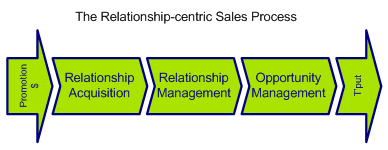
In summary, this process functions as follows.*
- Promotional dollars are invested in the acquisition of relationships — rather than in the direct acquisition of sales opportunities. Relationships are acquired by giving away packaged information (generally a book, white paper, or similar), in exchange for contact information. Because of the relative size of most organisations’ marketplaces, and the attractiveness of the offer, these campaigns are less prone to diminishing returns.
- Respondents are added to a database, subscribed to a periodical and invited to regular events. (Events are, by far, the most effective method for the stimulation of inbound sales opportunities.)
- Inbound sales opportunities are managed by the sales coordinator — where opportunity management consists simply of programming opportunities into the salesperson’s diary, in line with an appropriate strategy. (A strategy is the sequence of steps used to convert sales opportunities into sales.)
The promotional coordinator
Now that we understand the nature of the activities required to generate sales opportunities, we can complete the resourcing of our sales process.
Upstream from the opportunity buffer we add a resource we call a promotional coordinator.
The promotional coordinator is responsible for maintaining the opportunity buffer at its optimal size.
In order to achieve this requirement, the promotional coordinator manages a portfolio of relationship-acquisition and -management campaigns.
We now can be confident that the salesperson is both fully and productively utilised — and, consequently, that he will remain the capacity constrained resource.
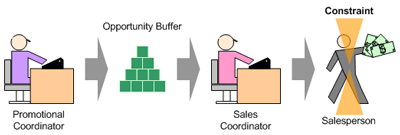
Managing the sales process
Conceptually, there is little difference between the management of a production process and the management of the sales process pictured on the previous page.
What differences there are, stem from the uncertainty associated with Throughput and intangible nature of both relationships and opportunities.
Throughput
Obviously, where a sales process is concerned, we are dealing with probable, rather than actual Throughput.
Accordingly, Throughput must be discounted for probability (or risk).
We must also acknowledge that the whole-of-life value of one sales transaction may be greater than the value of the initial transaction.
For this reason, Opportunity Throughput (TO) is equal to the risk-adjusted, net present value of the sales opportunity.

Probability
Traditionally, probability is estimated (subjectively) by salespeople. If the opportunity management process consists of one or more standardised strategies this is no longer necessary. All we have to do is select process milestones (stages) and determine the historical probability for opportunities at each stage.
The table below shows a typical set of stages with associated probabilities.
| Stage |
% |
||
|
8% |
||
|
23% |
||
|
38% |
||
|
67% |
||
|
98% |
Buffer size
The opportunity buffer consists of all sales opportunities — where these opportunities are at various stages of the opportunity management process.
You could visualise the opportunity buffer as an inventory of pending appointments. If, however, multiple appointments are required to close each appointment, you would have to remember that each appointment is likely to be connected to one or more others.
We can estimate the minimum number of opportunities that are required to keep the salesperson fully utilised by multiplying his daily capacity by the average opportunity cycle time, and then dividing the result by the average number of appointments consumed by each opportunity (some opportunities will never progress to first appointment, while others will consume multiple appointments).
Because Murphy will strike from time to time, this buffer needs to contain protective capacity. Experimentation has lead us to the conclusion that protective capacity should be an additional 50% of the minimum capacity.
The following example relates to the five-stage opportunity management process referenced previously. (It should provide some indication of the volume of concurrent opportunities that can be processed by a single salesperson.)
|
Optimal buffer size |
|
| CCR capacity (/day) |
5 |
| Opportunity cycle time (days) |
42 |
| Avg appointments/opportunity |
1.85 |
| Opportunities required for 100% utilisation [5 x 42 / 1.85] |
114 |
| Buffer size (opportunities) [114 x 1.5] |
170 |
Programming appointments
You’ll recall that we wish to replace intuition with a more objective method for programming appointments.
We can do this by:
- Estimating the contribution that each sales opportunity will make if it is allocated to an appointment slot.
- Indexing the opportunity buffer, based upon this probable contribution.
We start by revisiting our stages and adding the following:
Appointments pending: This is an estimate of the number of additional appointments that will be required to win the opportunity (this number cannot be less than one).
Maximum days: Because opportunities atrophy over time, this figure determines the point at which we will apply an additional discount. (These numbers are cumulative.)
| Stage |
Appts Pending |
Max Days |
||
|
3 |
28 |
||
|
2 |
42 |
||
|
1 |
56 |
||
|
1 |
70 |
||
|
1 |
84 |
We estimate the relative value of each opportunity using the following formula:

Overdue days is calculated by subtracting the max days value that is associated with the current stage from actual days (the number of days the opportunity has been open thus far.) The result must be a whole number*.
The following table is an example of three opportunities indexed using this method.
Assuming the same geographic region, the sales coordinator will program these opportunities into the salesperson’s diary in the order dictated by the index.
|
T |
Stage |
% |
TO |
Pend Appts |
O’due Days |
Relative Value |
Index |
|
$25,000 |
2 |
23% |
$5,750 |
2 |
0 |
$2,875 |
2 |
|
$12,000 |
4 |
67% |
$8,040 |
1 |
0 |
$8,040 |
1 |
|
$25,000 |
1 |
8% |
$2,000 |
3 |
5 |
$111 |
3 |
Performance indicators
We discussed earlier that the performance indicator for the sales process as a whole is Throughput per appointment slot available (T/ASA).
If we reflect on the contribution each team member must make to maximise T/ASA, it is easy to derive an objective and a performance indicator for each.
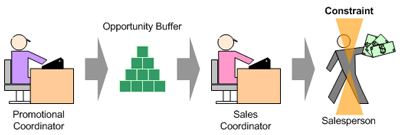
| Resource | Objective | KPI |
| Salesperson | Maximise Throughput for appointments conducted | T/ASC* |
| Sales coordinator | Maintain salesperson at 100% utilisation | Utilisation (% of optimal) |
| Promotional coordinator | Maintain opportunity buffer at optimal size | Buffer size (% of optimal) |
Each of these performance indicators should then be plotted on a run chart — providing each team member with a real-time, objective view of the contribution his activities are making to the goal of the system as a whole.*
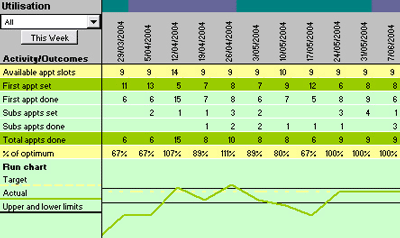
This objective approach allows us to dispense with targets, budgets, bonuses and commissions, performance reviews and management exhortations.
The sales process is now easy to manage and, consequently, easy to scale.
The result
The application of TOC to the sales process results in radical changes to process design, resourcing and management:
- Responsibility for all tasks other than the conduct of appointments is institutionalised.
- Non-constrained resources are applied to the acquisition and management of relationships and, accordingly, to the generation of sales opportunities.
- The opportunity-management process is standardised — and optimised, so as to maximise the return on the unit of constraint (appointment slots).
- Sales process cycle-time is reduced — often resulting in an increase in conversion rates.
- Salespeople require only product knowledge and communication skills (consequently, they are easier to recruit and retain).
- Commissions and bonuses cease to be necessary and the staffing mix shifts in favour of (lower-paid) sales support staff.
- Significant increases in Throughput can be expected for similar Operating Expenses and Investment.
 Applying the Theory of Constraints to the design, resourcing and management of the sales process
Applying the Theory of Constraints to the design, resourcing and management of the sales process